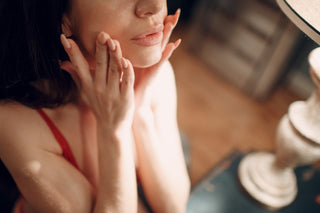Hyperpigmentation (skin discoloration) is more common than you think. But did you know there are different types of hyperpigmentation? If you’re unsure of the root of your discoloration, it helps to know what to look for so you can best treat it.
Today, we’ll share about all types of hyperpigmentation. By the end of this guide, you’ll be ready to pick the right hyperpigmentation treatment and unlock your dream complexion.
What is Hyperpigmentation?
The color of your skin, hair, and eyes comes from a substance called melanin, which is made up of skin cells. When these cells are damaged, they kick your melanin production into overdrive. As the melanin clumps together, parts of your skin darken and discolor. These discolored patches of skin are described as hyperpigmentation.
…But not all hyperpigmentation is triggered by the same things.
Mastering how to treat hyperpigmentation varies depending on important factors, such as:
- Where it’s occurring
- How long it’s been happening
- Potential exposure to the skin
Once you narrow down these factors, finding the right treatment and perfecting your skincare routine for hyperpigmentation gets much easier.
So grab an iced matcha latte, sit back, and get ready to take notes. It’s time to dive deep into the different types of hyperpigmentation and how to treat each one.
Periorbital Hyperpigmentation
Did you know that dark circles have a specific name? It’s periorbital hyperpigmentation. While most believe this results from sleep deprivation, there could be more to the story.
So what causes hyperpigmentation around the eyes? It could be any of the following:
- Lack of collagen (essential protein for healthy skin function)
- Photoaging (due to age, sun exposure, or environmental stressors)
- Leaky capillaries (blood vessels surrounding the eyes become inflamed)
- Poor blood circulation
- Stress or lack of sleep
Treatments
One way to remedy periorbital discoloration is to attack it with the right eye cream. Research shows that topical creams high in Vitamin C boost collagen and minimize the appearance of dark circles around the eyes. (Bonus: it also works for hyperpigmentation on legs, arms, and other parts of your face).
If you suspect stress or lack of sleep is the root of your dark circles, try prioritizing some relaxation. After all, who doesn’t deserve a little me-time?
Melasma and Hormonal Changes
Melasma is often nicknamed “the mask of pregnancy” because it’s common in up to half of all pregnant women. It tends to darken or lighten over time, often getting worse in the hotter months and better in the winter.
Melasma typically appears as brownish or bluish-gray patches. They can be symmetrical or freckle-like. This hyperpigmentation around the mouth may also appear on your cheeks, forehead, neck, stomach, and other areas.
Treatments
Most melasma typically fades if you protect yourself from sunlight and other harmful light sources. That means wearing SPF, hats, and protective chapstick for hyperpigmentation on your lips.
It’s also best to avoid:
- Hormone treatments (especially anything estrogen-related)
- Birth control (containing estrogen and progesterone)
- Blue light from tech screens
- Heavily-scented products
- Tanning beds/lamps
Other times, especially after pregnancy, melasma disappears on its own.
Post-Inflammatory Hyperpigmentation
One of the most common types of hyperpigmentation is post-inflammatory. This hyperpigmentation happens when skin cells experience trauma due to an injury or medical procedure. A prime example is post-acne scarring (or post-acne hyperpigmentation).
It’s characterized by tan, brownish, or blue-gray patches of hyperpigmentation on the neck, face, limbs, and anywhere following skin inflammation or injury.
Treatments
As your skin heals, the discoloration will usually fade on its own. As for scarring from hyperpigmentation acne, niacinamide and hyaluronic acid are a dynamic duo for treating post-inflammatory discoloration and making skin look more youthful.
Age Spots
As you go through the various types of hyperpigmentation, you’ll notice one repeating offender: sun damage. Age spots (also called sun spots or liver spots) result from too much UV light triggering melanin overproduction.
They appear as small, flat dark spots of various sizes. You’ll commonly find this hyperpigmentation on the face, hands, shoulders, arms, and places most exposed to the sun.
Treatments
Sunscreen is one of the best products for hyperpigmentation. As age spots result from too much UV exposure, shielding your skin from sunlight makes all the difference.
Some medications and dermatological procedures, like chemical peels or dermabrasion, can also help lighten age spots.
Familial Progressive Hyperpigmentation (FHP)
FHP, or genetic hyperpigmentation, meaning it’s passed down through your DNA, is one of the rarest types of hyperpigmentation.
This hereditary discoloration occurs anywhere on the body, from your face, torso, and limbs to hyperpigmentation on your buttocks and feet. It can appear as freckles or resemble the pattern presented in those with vitiligo (a condition in which the skin loses pigment).
Treatments
Since the origins of genetic hyperpigmentation are still being studied, narrowing down a definitive treatment can be tricky. In cases of FPH, it’s best to consult a dermatologist to explore your options.
Discoloration Doesn’t Stand a Chance.
Treating hyperpigmentation is an intimate journey with your complexion — don’t forget to show yourself a little compassion along the way. And remember: you’re beautiful at every stage of this journey.
As frustrating as hyperpigmentation in all forms can be, there is hope. Treatments for all types of hyperpigmentation can take anywhere from 6 to 12 months to see results, so try to be patient.
In the meantime, we’re on your side to help you embrace your best skin. Ready to tap into traditional beauty secrets with a modern twist? Shop Forever Beaumore today.


